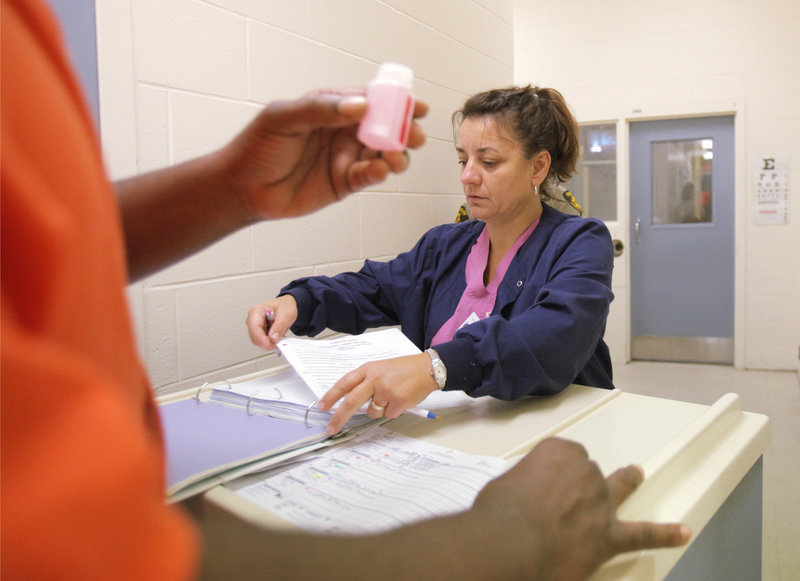BANGOR – Penobscot County Sheriff Glenn Ross remembers when running a jail was almost as simple as locking people up.
Maine’s prescription drug abuse epidemic has helped to change that.
“We are the state’s largest detox center,” Ross said. “It’s just an escalating problem for us.”
Most of the 6,000 or so inmates who come through the Penobscot County Jail in a year are taking some sort of medication, often for mental illness or opiate addiction.
All of the medications and medical care must be paid for by the jail, which is funded almost entirely by the county’s taxpayers.
The county’s budget for inmates’ medication alone has more than doubled since 2002, from $8,000 to $17,000 a month. “They come into our system in terrible shape,” Ross said.
The Penobscot County Jail is one of the Maine jails that provide methadone to inmates as a way to wean them off their pain-pill addictions in the first two weeks of incarceration.
While experts say more treatment and counseling in jail could reduce inmates’ addiction relapse rate after release, sheriffs in some other Maine counties say they can’t afford to treat all of the addicts they lock up.
“It would be an exorbitant cost for us to take on,” said Cumberland County Sheriff Kevin Joyce. It also would require medical training and licensing that the county doesn’t have, he said.
Counties that don’t provide treatment simply monitor addicts going through opiate withdrawal, and try to make them as comfortable as possible. Pregnant inmates are usually an exception. They receive treatment drugs to prevent withdrawal that can cause miscarriage or other complications.
All county jails have had to step up security to keep prescription painkillers from getting smuggled in.
Inmates routinely try to hide pills in body cavities. They sometimes succeed — officers recently found a hollowed-out plastic vibrator in the Cumberland County Jail, for example.
A 2007 lawsuit against strip searches led to new restrictions on jails. Corrections officers can strip search some felons, such as those charged with violent or drug-related crimes. Otherwise, officers need reasonable suspicion that inmates are concealing contraband.
Early this year, Cumberland County Jail supervisors discovered that inmates were being surreptitiously supplied with suboxone, a drug for addiction treatment that some addicts say can get them high. The drug is sometimes made as a thin strip designed to dissolve under the tongue. The strips, it turns out, were being hidden in the flaps of manila envelopes and between the paper in greeting cards.
“It was an eye-opener for us,” Joyce said. “It’s very hard to detect.”
Cumberland County inmates no longer get the manila envelopes — just the papers inside. Greeting cards are photocopied for the inmates, then destroyed, Joyce said.
Jails also have had to restrict visiting privileges in recent years to prevent the passing of pills and other drugs.
“We ended up having to put them on opposite sides of the table,” said Ross, the Penobscot County sheriff. “Then we ended up putting barriers under the table because they were passing drugs that way. Then we put barriers on top of the tables. (Inmates) were able to hold infants, and now we’ve had to stop that because drugs were being smuggled in the diapers.”
The jail also has had to more carefully watch patients who receive daily doses of methadone. Inmates have swallowed the liquid medication, then regurgitated it so they could sell it to other inmates, Ross said.
“It’s amazing how desperate these people have become, to do the things they do,” he said. “We used to be able to take people in the jail and let them out when their time was up.”
Staff Writer John Richardson can be contacted at 791-6324 or at: jrichardson@pressherald.com
Send questions/comments to the editors.



Success. Please wait for the page to reload. If the page does not reload within 5 seconds, please refresh the page.
Enter your email and password to access comments.
Hi, to comment on stories you must . This profile is in addition to your subscription and website login.
Already have a commenting profile? .
Invalid username/password.
Please check your email to confirm and complete your registration.
Only subscribers are eligible to post comments. Please subscribe or login first for digital access. Here’s why.
Use the form below to reset your password. When you've submitted your account email, we will send an email with a reset code.